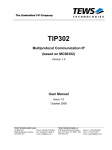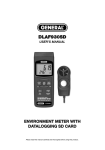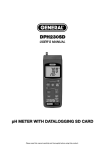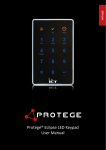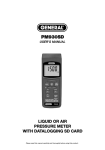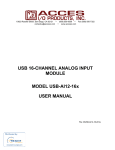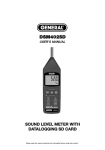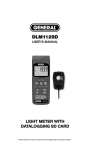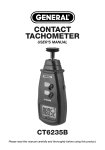Download CABLE & PIPE LOCATOR CL10 - General Tools And Instruments
Transcript
CABLE & PIPE LOCATOR USER’S MANUAL CL10 Please read this manual carefully and thoroughly before using this product. TABLE OF CONTENTS Introduction . . . . . . . . . . . . . . . . . . . . . . . . . . . . . . . . . . . . . . . . . . . . . . . . . . . . . . . . 3 Key Features & Benefits. . . . . . . . . . . . . . . . . . . . . . . . . . . . . . . . . . . . . . . . . . . . . 3 – 4 Safety Instructions . . . . . . . . . . . . . . . . . . . . . . . . . . . . . . . . . . . . . . . . . . . . . . . . . . . . 4 What’s in the Box . . . . . . . . . . . . . . . . . . . . . . . . . . . . . . . . . . . . . . . . . . . . . . . . . . . . . 4 Product Overview. . . . . . . . . . . . . . . . . . . . . . . . . . . . . . . . . . . . . . . . . . . . . . . . . . 5 – 6 Setup Instructions . . . . . . . . . . . . . . . . . . . . . . . . . . . . . . . . . . . . . . . . . . . . . . . . . . . . 7 Install Batteries . . . . . . . . . . . . . . . . . . . . . . . . . . . . . . . . . . . . . . . . . . . . . . . . 7 Install Test Leads . . . . . . . . . . . . . . . . . . . . . . . . . . . . . . . . . . . . . . . . . . . . . . . 7 Operating Instructions . . . . . . . . . . . . . . . . . . . . . . . . . . . . . . . . . . . . . . . . . . . . . 8 – 14 Single-Pole Circuit Applications . . . . . . . . . . . . . . . . . . . . . . . . . . . . . . . . 8 – 11 Locating a Cable or Line Break Behind a Wall . . . . . . . . . . . . . . . . . . 8 – 9 Locating a Socket, Switch or Junction Box or Tracing a Line . . . . . . . . . 9 Locating a Cable or Line Break Using Two Transmitters . . . . . . . . . . . . 10 Locating a Blockage in a Non-metallic Pipe . . . . . . . . . . . . . . . . . . . . . 11 Locating a Metal Water Pipe . . . . . . . . . . . . . . . . . . . . . . . . . . . . . . . . . 11 Two-Pole Circuit Applications. . . . . . . . . . . . . . . . . . . . . . . . . . . . . . . . . 12 – 14 Locating a Socket, Switch, Junction Box or Fuse or Tracing a Line. . . . 12 Identifying the Fuse or Circuit Breaker Associated with an AC Outlet . . 13 Locating a Short Circuit . . . . . . . . . . . . . . . . . . . . . . . . . . . . . . . . . . . . . 13 Increasing the Detection Range on Charged Circuits . . . . . . . . . . 13 – 14 Using the Receiver as a Voltmeter . . . . . . . . . . . . . . . . . . . . . . . . . . . . . . . . . 14 Specifications . . . . . . . . . . . . . . . . . . . . . . . . . . . . . . . . . . . . . . . . . . . . . . . . . . . . . . 15 Operating & Maintenance Instructions . . . . . . . . . . . . . . . . . . . . . . . . . . . . . . . 16 – 17 Changing Batteries. . . . . . . . . . . . . . . . . . . . . . . . . . . . . . . . . . . . . . . . . . . . . 16 Checking and Replacing the Transmitter’s Fuse . . . . . . . . . . . . . . . . . . 16 – 17 Operating & Maintenance Tips . . . . . . . . . . . . . . . . . . . . . . . . . . . . . . . . . . . . 17 Warranty Information . . . . . . . . . . . . . . . . . . . . . . . . . . . . . . . . . . . . . . . . . . . . . . . . . 18 Return for Repair Policy . . . . . . . . . . . . . . . . . . . . . . . . . . . . . . . . . . . . . . . . . . . . . . . 18 2 INTRODUCTION On jobs ranging from installing a through-the-wall air-conditioner to renovating a house with new wiring and plumbing, it is vital to know the locations of existing electrical cables and wires, as well as those of metal and non-metal pipes carrying water and gas. Without access to the building’s construction drawings, there is no way to be sure that an action as simple as driving a nail into a wall will not produce an electric shock—or far worse. The CL10 Cable & Pipe Locator was designed to address this serious safety issue with maximum flexibility. The CL10 consists of two main units—a transmitter and a receiver—and a set of accessories. The two main units work together in the following way in most applications. The user attaches the transmitter to an existing cable or wire (or metal pipe). In response to the push of front-panel buttons, the transmitter sends a radio-frequency current and a digital identifying code down the cable or wire. The current generates an electric field that can be sensed by the receiver if its nose (probe) is positioned nearby—even on the other side of a wall, floor or ceiling. Circuits in the receiver convert the weak induced voltage into a signal strong enough to be displayed graphically and digitally. Other circuits read the identifying code to confirm the source of the signal. By manipulating the strength of the transmitted signal and the sensitivity of the receiver, the user can precisely locate cables, wires or pipes behind walls or under floors, as well as discontinuities within them. The system is equipped with several functions and features that improve its utility, accuracy and reliability. One is the inclusion of big, bright LCDs, visual and audible indications, and mutable loudspeakers—as well as an LED flashlight—on both units. Another is the system’s full compatibility with single-pole and two-pole circuits. Other examples include the ability of either unit to measure AC/DC voltage, just like a voltmeter. The transmitter even automatically tests its own functioning and displays the results. KEY FEATURES AND BENEFITS • Makes it safe to break through a wall by revealing and locating hidden cables, electrical lines, and water/gas supply pipelines up to 6.6 ft. (2m) behind it • Eliminates the need to find and read construction drawings before starting a job • Detects breaks and short circuits in buried cables, electrical lines and floor-heating systems • Identifies the circuit breaker or fuse associated with any energized or de-energized 110V outlet • Traces branch-circuit sockets that have been accidently plastered over • Transmitter and receiver communicate using any of eight codes; each displays readings on a big, bright, multi-function graphic LCD. Both units also include a flashlight (for illuminating dark areas) and a mutable beeper/buzzer. • The transmitter displays its transmission power level (any of three levels), transmission code, battery status, any voltages it detects, and the results of its functional self-test • The transmitter or receiver also can operate as AC/DC voltmeter with a range of 12 to 600V 3 • The receiver has variable sensitivity, a backlit display, a loudspeaker and a 10-minute Auto Power Off function. It can display the transmitter’s power level and transmission code, the battery status of both units, and the amplitude of detected induced AC voltages • Both units are compatible with one- and two-pole circuits • Additional transmitters are available to make locating short-circuits and cable breaks more accurate • Includes a metal grounding rod • The transmitter is powered by one 9V battery; the receiver by six “AAA” batteries SAFETY INSTRUCTIONS Prior to using the transmitter, inspect the unit, its test leads and any attached clips or probes carefully for any signs of damage or wear. It is crucial that the instrument and its accessories remain structurally sound. DO NOT USE the transmitter if you detect any signs of damage. Do not exceed the transmitter’s overvoltage rating of CAT III 300V at any time. Although it is safe to connect the transmitter directly to live circuits, use best-practice insulation measures in accordance with industrial safety codes to avoid electric shock and harm. When near dangerously high voltages, make measurements only under the supervision of a qualified electrician. WHAT’S IN THE BOX The CL10’s transmitter, receiver and accessories come in a black canvas pouch inside an illustrated cardboard box. 1. Pouch 2. Receiver 3. Transmitter Accessories 4. Attachable red and black alligator clips with shrouded banana jacks 5. “9V” battery 6. 6 “AAA” batteries 7. User’s manual 8. 5 ft. (1.5m) long red and black universal test leads with shrouded banana plugs 9. Attachable red and black test probes with lantern-type tips and shrouded banana jacks 10. Grounding rod Fig. 1. How the CL10 is packaged 4 PRODUCT OVERVIEW 1. LCD 2. (POWER on/off) button 3. Transmission power (I, II or III) LEVEL SEL. button 4. Transmitting code START/STOP transmission button 5. Transmitting CODE SEL. button. Press and hold to enter selection mode; press briefly to exit. 6. ▼ button (press to reduce power level/change transmitting code). Levels I, II and III and codes F (default), E, H, D, L, C, O and A are available. 7. ▲ button (press to increase power level/change transmitting code) 8. (Mute) on/off button 9. (Flashlight) on/off button 10. + jack 11. (ground) jack 12. Flashlight (on top) 13. Fold-out stand (on back) 14. Battery compartment (on back) 1. (Transmitter battery status) icon 2. Transmission power level (I, II or III) 3. Transmitting code 4. AC line voltage 5. DC line voltage 6. Line voltage measured (in voltmeter mode) 7. Transmitting status 8. Code being transmitted 9. Transmission signal amplitude 10. (Line voltage detection mode) icon 11. (Mute on) icon 쐉 씈 씉 Fig. 2. The transmitter’s controls, display and physical features Fig. 3. All possible indications on the transmitter’s LCD 5 1. Flashlight 2. Probe 3. LCD 4. (Power on/off) button 5. Two-function (backlight/mute) button. Press briefly to turn LCD backlight on and off; press and hold to enter/exit mute mode (in which the loudspeaker and button presses are silenced). 6. (Flashlight) on/off button 7. UAC button (press to exit cable locating mode and enter line voltage detection mode) 8. MANUAL button (press to enter manual cable locating mode, enabling receiver sensitivity to be reduced). 9. ▼ button (press to reduce receiver sensitivity in manual cable locating mode) 10. ▲ button (press to increase receiver sensitivity in manual cable locating mode) 쐉 11. Loudspeaker (on bottom) Fig. 4. The receiver’s controls, 12. Battery compartment (on back) display and physical features 1. (Receiver battery status) icon 2. (Transmitter battery status) icon 3. Received transmission power level (I, II or III) 4. MANUAL cable locating mode indication 5. AUTOmatic cable locating mode indication 6. One of the following indications: • In automatic cable locating mode, a number indicating received signal amplitude • In manual cable locating mode, the text SEL (indicating no received signal) or a number indicating received signal amplitude • In line voltage detection mode, the text UAC. 7. Concentric circles graphically representing the Fig. 5. All possible indications current receiver sensitivity. More circles indicate on the receiver’s LCD higher sensitivity; fewer circles indicate lower sensitivity. 8. Received transmitting code 9. Received signal amplitude 10. (Line voltage detection mode) icon 11. (Mute on) icon 6 SETUP INSTRUCTIONS INSTALL BATTERIES The CL10 transmitter is powered by one “9V” battery (included). The CL10 receiver is powered by six “AAA” batteries (also included). To install the “9V” battery in the transmitter: 1. Turn the unit over and lift the fold-out stand (Fig. 2, Callout 13) to expose the battery compartment (Callout 14). 2. Remove the one Philips-head screw securing the battery compartment cover and set it aside. 3. Remove the battery compartment cover and set it aside as well. 4. Install the supplied “9V” battery in the compartment, making sure to match the polarity marks on the battery and the flanged connectors. 5. Replace the battery compartment cover and secure it with the Philips-head screw. To install the “AAA” batteries in the receiver: 1. Turn the unit over. 2. Remove the one Philips-head screw securing the battery compartment cover (Figure 4, Callout 12) and set it aside. 3. Remove the battery compartment cover and set it aside as well. 4. Install the six supplied “AAA” batteries in the compartment, making sure to match the polarity marks on the batteries with the marks stenciled inside the compartment. 5. Replace the battery compartment cover and secure it with the Philips-head screw. INSTALL TEST LEADS All applications, with the exception of detecting line voltage (see p. 14), require use of the transmitter and the supplied red and black test leads (Fig. 1, Callout 8). To install the test leads, remove the four caps protecting the shrouded banana plugs at both ends of the leads. Insert the plug at either end of the red lead into the + jack (Fig. 2, Callout 10) on the top of the transmitter. Insert the plug at either end of the black lead into the jack (Callout 11). The type of application will determine whether to attach the alligator clips (Fig. 1, Callout 4) or the Lantern-type test probes (Callout 9). In most cases, the alligator clips are preferable because they produce a hands-free connection. If you do use the test probes, remember to remove both sets of caps protecting the probes’ shrouded banana plugs and lantern-type tips. Both accessory types are equipped with banana plugs that you push into the banana jacks of the test leads to make secure connections. 7 OPERATING INSTRUCTIONS SINGLE-POLE CIRCUIT APPLICATIONS For all single-pole applications described in this section, the transmitter is connected to only one conductor of a cable or AC line. The return is to ground (earth). In all of the applications in this section, the transmitter sends a digital code and an analog signal at the radio frequency (RF) of 125 kHz through the conductor to ground. Locating a Cable or Line Break Behind a Wall 1. Attach the clip or probe at the end of the transmitter’s red test lead to the conductor of the cable or line suspected of having a discontinuity. 2. Attach the clip or probe at the end of the black test lead to a suitable ground. All other cables or lines in the bundle must also be connected to the same ground (Fig. 6). 3. Power on the transmitter by pressing the (POWER) button. The LCD will “wake up” and the beeper will sound. If the transmitter’s battery is Fig. 6. Locating a adequately charged and the mute is turned off, the cable break only indications on the transmitter’s initial screen will be LEVEL I and CODE F, both on the left side. 4. Press the LEVEL SEL. button. The LEVEL I indication will flash. Press the ▲ button once or twice to raise the transmission power level to II or III, respectively. (If you know that the cable or line “hugs” the back side of the wall, keep the power level at I; otherwise, raise it to II or III.) Then press the LEVEL SEL. button again to save the setting. 5. Press the START/STOP button to begin sending an RF signal and transmitting code “F” over the cable or line. Concentric circles will appear on the transmitter’s LCD display and gradually spread, the transmitting code F will appear at lower right, and the special graphic (Fig. 2, Callout 9) will indicate the transmission amplitude. 6. Power on the receiver by pressing the button. The LCD will “wake up” and the beeper will sound. If the receiver’s battery is adequately charged, the only indications on the receiver’s initial screen will be the text AUTO at lower left (indicating that the unit is in automatic cable locating mode, the default state) and a set of concentric circles in the middle. 7. Move the probe of the receiver (Fig. 4, Callout 2) slowly along the wall away from where the transmitter is connected. At this point, the receiver’s LCD should be displaying the transmission power level (Fig. 4, Callout 3), the transmitting code “F” (Callout 8) and the received signal amplitude (Callouts 6 and 9). As the probe moves, the tone of the beeper also changes with the amplitude of the received signal. 8 8. When the probe of the receiver passes the location of the cable or line break, both indications of received signal amplitude will show a sharp reduction and then disappear. At this moment, press the MANUAL button on the receiver (Fig. 4, Callout 8) and move the probe slightly back in the opposite direction. 9. With the receiver now in manual cable locating mode, press the ▼ button to begin reducing the receiver’s sensitivity. Continue to move the probe in the original direction until the LCD loses the transmitting code, and then move the probe back slightly. If the LCD never loses the code, press the ▼ button again to further reduce the receiver’s sensitivity and then move the probe again. The point at which the receiver’s LCD can barely display the transmitting code is the location of the cable or line break. Locating a Socket, Switch or Junction Box or Tracing a Line Before performing the following procedure, make sure the circuit is dead (unpowered) and that its neutral line and ground wire are connected and fully operational. Any exposed grounding terminal can be used to ground the transmitter. For line tracing applications, the typical maximum depth is 7 ft. To locate a circuit component or trace a line: 1. Attach the supplied red alligator clip or red test probe (depending on the application) to the transmitter’s red test lead and then connect the clip or probe to a component known to be part of the circuit, as in Fig. 7. 2. Attach the supplied black alligator clip or black test probe to the transmitter’s black test lead and then attach the clip or probe to an auxiliary ground, a ground terminal of a grounded socket, or a properly grounded water pipe. Fig. 7. Locating a Socket, Switch or 3. Follow Steps 3 through 9 of the procedure detailed Junction Box or Tracing a Line in “Locating a Cable or Line Break Behind a Wall” on p. 8. Remember that if the cable fed by the transmitter runs in parallel with other conductors (for example, in a cable duct) or if those conductors are crossed, the transmitter’s signal is also carried by those other conductors. 4. As in the previous application, a component or line can be precisely located by adjusting the transmitter’s output power and then operating the receiver in manual mode and adjusting its sensitivity. In both of these applications, the stronger the signal received, the closer the receiver is to the component to be located or the line to be traced. When tracing a line, an abrupt decline in received signal power indicates a line break. 9 Locating a Cable or Line Break Using Two Transmitters Attempts to locate a cable or line break by feeding the transmitter’s signal into a conductor from one end may not succeed if stray electromagnetic fields are present. One way to solve this problem is to attach a second transmitter to the conductor at its opposite end. Additional transmitters (Part No. CL10T) are available from General. For more details or to order, enter “CL10T” in the SEARCH box at www.generaltools.com. Before you begin, make sure that the circuit is dead (unpowered) and that all transmitters and all cables Fig. 8. Using two transmitters to or lines not being investigated are properly grounded, locate a cable or line break as in Fig. 8. To proceed, connect both transmitters as shown in Fig. 8. Then follow Steps 3 and 4 of the procedure detailed in “Locating a Cable or Line Break Behind a Wall” on p. 8. However, following Step 4 press and hold the CODE SEL. button of the second transmitter. This will cause the text CODE F on the left side of the LCD to begin flashing. Press the ▲ button five times to change the code from F to C. Then press and hold the CODE SEL. button again to save the setting. With the first transmitter sending Code F and the second transmitter sending Code C, complete the procedure by performing Steps 5 through 9. The same CL10 receiver will display different codes on either side of the cable or line break. When the receiver displays no code, it is positioned directly at the break, where the codes overlap. The use of two transmitters is particularly effective at pinpointing breaks in electric floor heating systems characterized by extremely long conductors. There are only two constraints on the technique: 1. If a shield mat is located above the heating wires, no ground connection may exist. If necessary, separate the shield from the ground connection. 2. In addition to ensuring good grounding, make sure that there is considerable distance between the grounding terminal of the transmitter and the target line. If this distance is too short, it may be impossible to precisely locate the line. 10 Locating a Blockage in a Non-metallic Pipe The basic procedure used in all of the previous applications also can be used to locate a blockage in a non-conductive (plastic, for example) pipe. In this case, the + terminal of transmitter is connected to a metal tube or piece of flexible conduit thin enough to be fed into the pipe, as shown in Fig. 9. When the signal induced in the receiver drops off sharply, the receiver is directly above the blockage. Locating a Metal Water Pipe Fig. 9. Locating a blockage in a The basic procedure used in all of the previous non-metallic pipe applications can even be used to detect the presence of a hot or cold water pipe made of metal (such as galvanized steel). Before proceeding: • Make sure that all electrical equipment connected to the water distribution system is powered off. • Make sure that the pipe to be located is not grounded. If the impedance between the pipe and ground is not large enough, the location distance will be very short. •Use a wire to connect the transmitter’s jack to ground. Fig 10. Locating a cold (left) or hot (right) metal water pipe 11 TWO-POLE CIRCUIT APPLICATIONS For all two-pole applications (U.S. 240VAC) described in this section, you will create a closed circuit by attaching both test leads of the transmitter to the power circuit’s conductors (lines). The exact connection depends on whether the power circuit is live (energized) or dead (de-energized). For live circuits: Connect the transmitter’s + jack to the phase line and the jack to the neutral line. If the circuit is unloaded, the modulated output of the transmitter will be coupled into the neutral line by the circuit’s distributed capacitance and then return to the transmitter. For dead circuits: Connect the transmitter’s + jack to a terminal of any conductor, connect the jack to the terminal of another parallel conductor, and then connect the other two terminals of the circuit to each other. In this configuration, the modulated output of the transmitter will directly return to it through the power circuit. Alternatively, the two test leads of the transmitter can be connected to the two ends of the conductor. Or the transmitter’s + jack can be connected to a terminal of any conductor while the jack can be connected to the power circuit’s protective grounding terminal. Locating a Socket, Switch, Junction Box or Fuse or Tracing a Line For all applications in this section: • If the circuit is dead, the transmitter only sends a transmitting code to the component to be located. • If the circuit is live, the transmitter not only sends encoding signals to the circuit to be detected, but also measures and displays the voltage of the live circuit. Fig. 11 shows how to connect the transmitter and Fig. 11. Locating a socket, switch, how to position the receiver to locate various junction box or fuse or tracing a line components. Note the similarities and differences between this configuration and the configuration for single-pole circuits shown in Fig. 7. To proceed, use the same procedure used for “Locating a Cable or Line Break Behind a Wall” section on p. 8. As before, a component or line can be precisely located by adjusting the transmitter’s output power and then operating the receiver in manual mode and adjusting its sensitivity. In both of these applications, the stronger the signal received, the closer the receiver is to the component to be located or the line to be traced. When tracing a line, an abrupt decline in received signal power indicates a line break. 12 Identifying the Fuse or Circuit Breaker Associated with an AC Outlet Unlike inexpensive AC-powered circuit breaker finders, the CL10 can identify the breaker associated with an outlet of a de-energized circuit because the CL10’s transmitter is battery-powered. Before proceeding with this application, you should reduce the transmitter’s output Fig. 12. Identifying the fuse or circuit current to a suitable level. Then connect breaker associated with an ac outlet the transmitter to the outlet as shown in Fig. 12. The next step is to open the door of the distribution panel (breaker box). You will touch the probe on top of the receiver to all breakers or fuses in the distribution panel in turn. The breaker or fuse that produces the strongest signal in the receiver is the one associated with the outlet that the transmitter is plugged into. Locating a Short Circuit A procedure virtually identical to the one on p. 8 can be used to locate a short circuit in a two-pole circuit. The only difference is that the transmitter is connected as shown in Fig. 13. Before proceeding, de-energize the circuit. Then try to determine the impedance of the short circuit. When searching for short circuits in coated electric wires and cables, the depth of detection may vary because the core wires are twisted together in the Fig. 13. Locating a jacket. Experience has it that only short circuits with short circuit a impedance lower than 20 ohms can be detected. The impedance of a short circuit can be measured with a multimeter. If the impedance of a short circuit is higher than 20 ohms, try to use the procedure for locating a cable or line break to locate the short circuit. In doing so, it may help to increase the output power of the transmitter. Increasing the Detection Range on Charged Circuits When the transmitter is connected to a two-pole circuit’s phase and neutral lines, transmitted signals are physically carried in parallel. As a result, the twisting of conductors may cause signals to cancel each other out. This effect may reduce the transmitter’s radius of effective detection to 2 ft. or less. 13 To counter this effect, consider making the connection shown in Fig. 14. Use of a cable reel can increase the transmitter’s effective radius to 10 ft. or more. USING THE RECEIVER AS A VOLTMETER Fig. 14. Using a cable reel to To use the receiver as a voltmeter: increase the transmitter’s 1. Press the UAC button (Fig. 3, Callout 7). The detection radius text UAC will appear at the bottom left of the LCD. 2. Position the probe near a current-carrying line. The strength of the induced signal will be indicated by the length of the received signal amplitude graphic (Fig. 4, Callout 9) and the tone of the beeper (if not muted). The higher the voltage and the shorter the distance to the circuit, the longer the graphic and the higher the beeper frequency. 3. If line voltage is detected, the familiar “Danger-AC Voltage” icon will also appear on the LCD, on the top line. 14 SPECIFICATIONS Transmitter Output Signal Frequency Voltage Measurement Range/Accuracy Display Dielectric Strength Overvoltage Rating Power Consumption Fuse Rating/Dimensions Operating Temperature Storage Temperature Dimensions Weight Power Source Receiver Line Voltage Detection Range Cable & Pipe Single-pole Applications Location Range Two-pole Applications Display Auto Power Off Trigger Operating Temperature Storage Temperature Power Consumption Dimensions Weight Power Source 125 kHz 12 to 600V AC or DC /±2.5% 2.4 in. (61mm) diagonal LCD 400V AC/DC, max CAT III 300V 31mA (min), 115mA (max) 500mA @ 1000V/6.3mm (diameter) x 32mm (long) 32° to 104°F (0° to 40°C) @ <80% RH -4° to 140°F (-20° to 60°C) @ <80% RH 7.5 x 3.5 x 1.7 in. (190 x 89 x 43mm) 12.7 oz. (360g) without battery; 14.8 oz. (420g) with battery One “9V” battery ~1.3 ft. (0.4m) ~6.6 ft. (2m) ~ 2 ft. (0.5m) 2.4 in. (61mm) diagonal LCD with backlight 10 minutes of inactivity 32° to 104°F (0° to 40°C) @ <80% RH -4° to 140°F (-20° to 60°C) @ <80% RH 32mA (min), 89mA (max) 9.5 x 3.1 x 1.5 in. (242 x 78 x 39 mm) 9.9 oz. (280g) without battery; 12.3 oz. (350g) with battery Six “AAA” batteries 15 OPERATING & MAINTENANCE INSTRUCTIONS CHANGING BATTERIES When the icon on the transmitter or receiver, or the icon on the receiver begins to flash, it’s time to change the power source of the indicated unit. Before proceeding to change the transmitter’s “9V” battery, power off the unit and all circuits to which it is connected and remove all connecting wires. Detailed instructions for changing the transmitter’s battery and the receiver’s batteries are found on p. 7 of this manual. If you do not expect to use the transmitter or receiver for a relatively long time (several months), remove its battery to avoid the possibility of battery acid leaking and causing damage. CHECKING AND REPLACING THE TRANSMITTER’S FUSE The transmitter’s fuse is designed to prevent the unit from being damaged by overload or misuse. If the fuse blows, the transmitter will be able to transmit only weak signals. If the unit passes its functional self-test but the signal it generates is weak, it is likely that the fuse has been blown. If the self-test detects no generated signal and the battery is adequately charged, it is likely that the entire unit requires repair. In this case, if the CL10 is under warranty, contact General’s Customer Service Department to arrange to return the unit for repair. To check whether the transmitter’s fuse has blown: • Disconnect the transmitter from all external circuits. • Plug in both test leads. • Power on the unit and press the LEVEL SEL. button to choose Level I. • Press the START/STOP button. • Power on the receiver and move its probe near the red test lead. • If the fuse has not blown, the receiver will display a strong signal. If the fuse blows while the CL10 is still under warranty, you should contact General’s Customer Service Department to arrange to return the transmitter for outfitting with a new fuse. While the unit is under warranty, you should NOT attempt to replace the fuse yourself. Replacing the fuse requires opening the transmitter’s housing, and doing so voids the warranty because it could disable the unit’s internal safety circuits. If the fuse blows after the warranty period has expired, you can replace it yourself with a fuse of the same rating and dimensions. The factory-installed fuse is a single-metal-wire, fast-acting type. DO NOT replace it with either a helical-metal-wire fuse or a slow-blow unit. 16 To change the fuse (if it blows following expiration of the 1-year limited warranty term), you must open the CL10’s housing. To do so: 1. Turn the unit over and remove the two Philips-head screws at the top corners of the back half of the housing. 2. Remove the one Philips-head screw securing the battery compartment cover to the back. 3. Lift the cover to expose the other two Philips-head screws securing the two halves of the housing to each other. Remove those two screws as well. 4. Carefully separate the two halves of the housing as far as the two flanged connectors in the battery compartment allow. The transmitter’s fuse—a white cylinder with silvered sleeves on both ends—should be visible seated in its holder. 5. Carefully pry the fuse out of the holder and replace it with a fast-acting ceramic fuse with a rating of 500mA @ 1000V and dimensions of 6.3mm (diameter) x 32mm (long). 6. Carefully reassemble the housing by replacing the five screws in the reverse order in which they were removed. OPERATING & MAINTENANCE TIPS DO NOT expose either the transmitter or the receiver to: • Direct sunlight • High humidity or temperatures (above 104°F/40°C during operation or 140°F/60°C in storage) • Corrosive or explosive gas • Excessive dust • Strong mechanical vibration or stress (dropping, for example) or electromagnetic radiation Before using a transmitter or receiver that has been subjected to extreme temperatures, allow several hours for it to acclimate to your local conditions. Do not open the housing of either the transmitter or receiver (except to replace the transmitter’s fuse after the 1-year limited warranty period has expired). Opening the housing of, or disassembling either unit voids the product warranty and could disable its safety circuitry. You may clean the housing of the transmitter or receiver with a clean rag and water or a mild detergent. Never use benzene, alcohol, acetone, ether, ketone, paint thinner or gasoline. After cleaning a unit, allow it to dry thoroughly before using it again. Use a rag dipped with clean water or neutral detergent to wipe the transmitter, and then use a dry rag to wipe it again. 17 WARRANTY INFORMATION General Tools & Instruments’ (General’s) CL10 Cable & Pipe Locator is warranted to the original purchaser to be free from defects in material and workmanship for a period of one year. Subject to certain restrictions, General will repair or replace this instrument if, after examination, the company determines it to be defective in material or workmanship. This warranty does not apply to damages that General determines to be from an attempted repair by non-authorized personnel or misuse, alterations, normal wear and tear, or accidental damage. The defective unit must be returned to General Tools & Instruments or to a General-authorized service center, freight prepaid and insured. Acceptance of the exclusive repair and replacement remedies described herein is a condition of the contract for purchase of this product. In no event shall General be liable for any incidental, special, consequential or punitive damages, or for any cost, attorneys’ fees, expenses, or losses alleged to be a consequence of damage due to failure of, or defect in any product including, but not limited to, any claims for loss of profits. RETURN FOR REPAIR POLICY Every effort has been made to provide you with a reliable product of superior quality. However, in the event your instrument requires repair, please contact our Customer Service to obtain an RGA (Return Goods Authorization) number before forwarding the unit via prepaid freight to the attention of our Service Center at this address: General Tools & Instruments 80 White Street New York, NY 10013 212-431-6100 Remember to include a copy of your proof of purchase, your return address, and your phone number and/or e-mail address. 18 NOTES ______________________________________________________________________ ______________________________________________________________________ ______________________________________________________________________ ______________________________________________________________________ ______________________________________________________________________ ______________________________________________________________________ ______________________________________________________________________ ______________________________________________________________________ ______________________________________________________________________ ______________________________________________________________________ ______________________________________________________________________ ______________________________________________________________________ ______________________________________________________________________ ______________________________________________________________________ ______________________________________________________________________ ______________________________________________________________________ ______________________________________________________________________ ______________________________________________________________________ ______________________________________________________________________ ______________________________________________________________________ ______________________________________________________________________ ______________________________________________________________________ ______________________________________________________________________ ______________________________________________________________________ ______________________________________________________________________ 19 GENERAL TOOLS & INSTRUMENTS 80 White Street New York, NY 10013-3567 PHONE (212) 431-6100 FAX (212) 431-6499 TOLL FREE (800) 697-8665 e-mail: [email protected] www.generaltools.com CL10 User’s Manual Specifications subject to change without notice ©2012 GENERAL TOOLS & INSTRUMENTS NOTICE - WE ARE NOT RESPONSIBLE FOR TYPOGRAPHICAL ERRORS. MAN#CL10 5/15/12





















